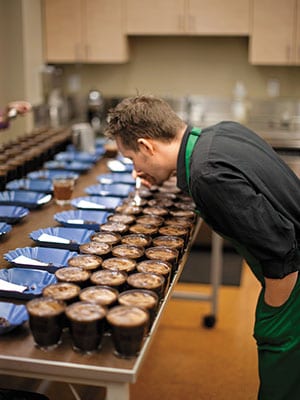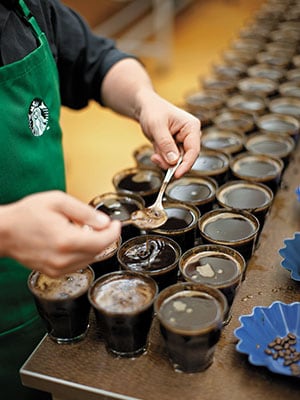
Behind the scene at Starbucks
How Starbucks employees—or partners, as they are called—taste coffee and camaraderie in Seattle
At first glance, the starbucks center in Seattle is a run-of-the-mill building, no different from the average office block found in America’s suburban sprawl. The dull façade is long-standing: Consider that the headquarters of the coffee retail giant once housed a Lowe’s department store. It is inevitably drab, with a huge parking lot, a small foyer and an elevator lobby, tucked away within which is another unremarkable sight in Seattle—a Starbucks store. So far, it is a bit of a let-down. This was the mothership, and I’d expected something more, well, Starbucks-ey.
A minute’s walk later, though, I am quickly forced to revise my knee-jerk impression. I reach the reception area where the unmistakable aroma of coffee from around the world hangs in the air—some chocolatey, some fruity and others tart. The walls are decorated with coffee nostalgia and, as I go further inside, in the middle of the HQ, there are live coffee plants that are watered and nurtured every day. Oh, and then there’s— surprise, surprise—a large Starbucks outlet. Yes, I’ve judged too soon. This was beginning to smell like a fascinating journey into the American coffee mecca.
What could possibly be special about a Starbucks outlet in a Starbucks office? Consider this: Employees stand in long queues and pay for coffee that can be had for free at any of the 24 pantries in the building. No one’s quite sure why they do that. It is yet another vindication of founder-chairman-CEO Howard Schultz’s vision to make Starbucks the third place—the one between home and work— where people congregate for coffee and conversation. At 9.30 am on a weekday, the store is alive with orders ranging from decafs to lattes in all their customised avatars. You would be hard-pressed to find a stronger endorsement of a Starbucks store.
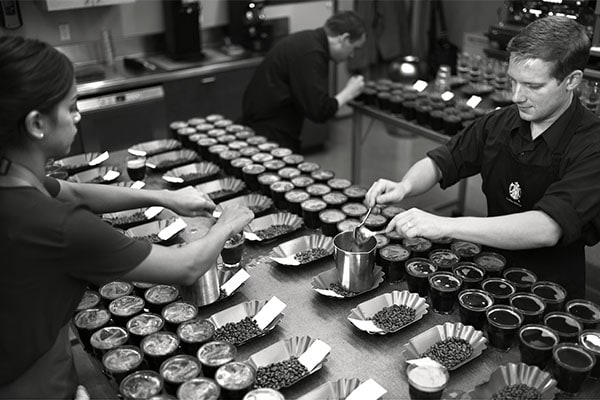
At the headquarters, a partner tasting the blend
The camaraderie and passion for coffee at the Starbucks Center reminds me of a visit to the Tata Coffee plantations in Kushalnagar, Karnataka. In October last year, Tata Starbucks had invited a small group of journalists to taste their Indian coffee blends. We slurped (see box on coffee-tasting etiquette) our way through half a dozen varieties. While we were no experts, we could still gauge the subtle differences in taste—a matter of some pride, as all amateur tasters will verify.
This March morning, though, I am to participate in a coffee-tasting session at the homeground. As someone who is willing to walk an extra mile for a better cup of coffee, this will be an experience to savour. For one, the sheer range of varieties on offer. For the other, I was to be taken through the process by Major Cohen, their resident expert. Short and unassuming, Major (everyone calls him that and everyone knows him) started out at a Starbucks store in Boston and his passion for coffee led him to its HQ where he is now an authority on blends.
This session is also as close to an insider view one is likely to have into why Starbucks has been able to outperform rivals such as Peet’s Coffee & Tea and Philz Coffee over the last three decades. Everyone from Schultz down has been instilled with a love for coffee that is unmistakable.
Every morning at nine, there are informal coffee-tasting sessions conducted only for employees (outsiders like me occasionally luck in). On the day I visited, there were about a dozen employees who were given two cups of the same coffee and asked to explain why they tasted as different as they did. After ten minutes of flailing for the right answer, they were told that it was because the French press had not been cleaned properly in one of the cases.
Then there are the coffee-tasting certification courses that employees can participate in. The idea: Its partners (that’s what Starbucks employees are called) should be the most knowledgeable on any type of coffee. Of course, there’s no compulsion, but almost everyone takes them.
After sharing that background, Major takes me through another coffee cupping. But before that he lets me in on a little secret. “Before I came to Seattle I thought blending was a highly complex process,” he says. He learnt differently. In 2003, during his first summer after moving to Seattle, Major was cupping every day. One afternoon out of the blue, he was told that they would start work on their Christmas blend, which would include Latin American, Sumatran and aged Sumatran coffee.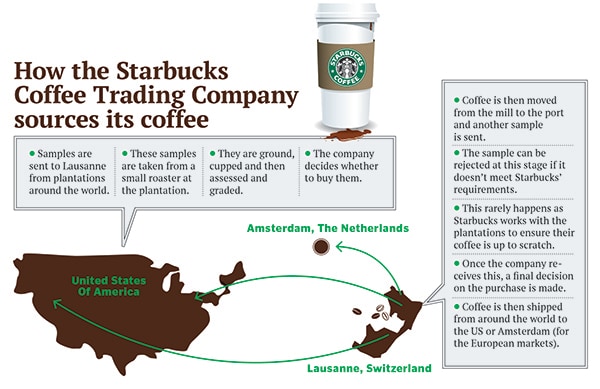
Various samples were placed around the room and they started tasting them, working their way through various permutations and combinations. The contents of each blend were jotted on a card and placed next to the cup. Subsequently, the blends were sampled by senior staff. The process is a bit of a hit-and-miss, but since they’re a competitive bunch, having your blend picked is a matter of pride. (This was one of the instances, though, when Major’s blend did not get chosen, he says. No worries. He has tasted success often enough to balance out the misses.)
Today Major has chosen a restaurant blend that the company has made for customers who order coffee with their post-meal savouries and sweets: Starbucks Reserve Microblend Number 11. The two constituents of the blend—an Ethiopian coffee and one from Guatemala—will also be tasted separately.
I’m asked to smell the three coffee bags lying in front of me. Each has its own distinct smell—one fruity, the other chocolatey and the third falling somewhere in between. We pour hot water and wait for it to cool. Meanwhile, Major regales me with anecdotes about how he likes his coffee; how many cups he has in a day; why he considers it the best beverage around. He’s also been to India for the launch of the India Estate Blend and considers himself a fan of the coffee. He promises it will be available globally in due course. (Incidentally, Tata Starbucks is trying to inculcate the same coffee-tasting culture among its employees. At their India headquarters in Mumbai’s Lower Parel, employees begin the week with such sessions.)
Once the coffee cools down, it’s time to get dirty. “Breaking the crust” is a must for coffee cupping. It involves taking a spoon and puncturing the crust that forms on top. One must smell the aromas that waft out to get a sense of how strong the coffee is. This is done individually for each cup and must be completed before the actual tasting begins. 
I start with the Guatemalan coffee. I slurp it and then roll it around the tongue much like I would with wine. Some tasters prefer to swallow while others spit it out in the fancy pair of oblong spittoons Starbucks keeps handy for this purpose. I get an unmistakable citrus smell along with a slight hint of cocoa. The coffee is a rich dark colour and has the quality of something you’d want to drink on waking up.
The Ethiopian coffee, meanwhile, has a distinct tart flavour—a tangy taste that hits you the moment it touches your tongue. Major tells me it is a mix of strawberry, cherry and chocolate. The coffee tastes a lot coarser and I tell him I don’t like it. He chuckles and indicates that he agrees, although he hastens to add that it is a matter of personal taste.
Before we move to the Reserve Microblend Number 11, Major explains that it was prepared with seven parts Guatemalan and three parts Ethiopian. On first slurp, it tastes like the perfect complement to a meal. I imagine it as an ideal pairing with my tiramisu after a hearty dinner. Again like wine, each coffee blend is a result of the “cyclical product of nature”, Major points out. If the weather changes, so do the coffee beans —ever so slightly—but even so, getting these blends consistent annually is the biggest challenge.
Once we’re done, Major has to prove his last point and he does it in style. He asks me if all three coffees tasted very different. When I agree, he takes seven spoons of the Guatemalan and three spoons of the Ethiopian and mixes them in a glass. The Starbucks Reserve Microblend Number 11 is ready. And it smells the same as the coffee that came out of the microblend bag.
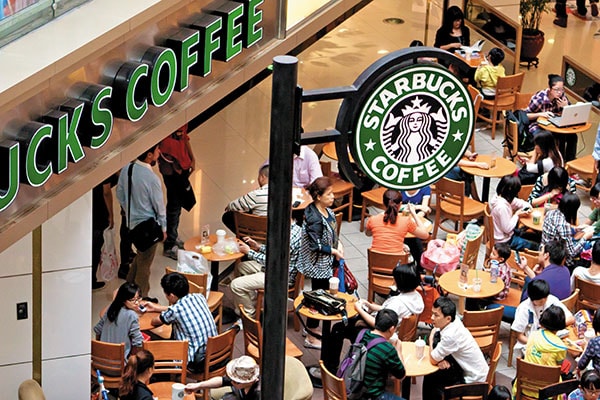
Image: Corbis
That’s when it all falls into place. The seeming perfection of the product cloaks an imperfect science. One that relies on the human instinct as thousands of cups get tasted before arriving at the ideal combination.
I have rarely left a Starbucks store without a takeaway. This time around, too, I had it piping hot but stirred with a dash of learning: That with coffee and blending, as in life, there are no right or wrong answers. To each his own.
(This story appears in the May-June 2014 issue of ForbesLife India. To visit our Archives, click here.)

